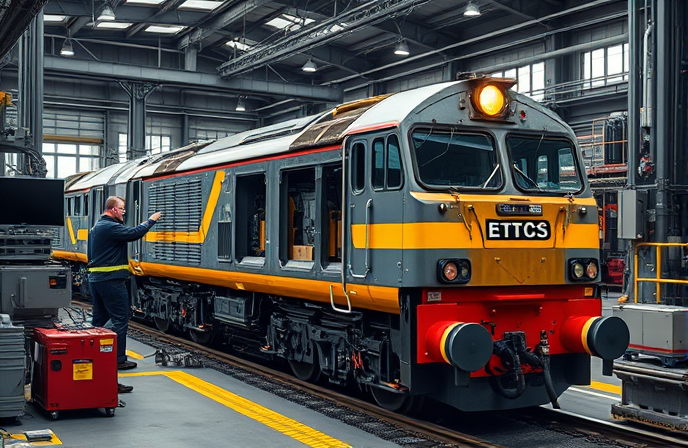UK Rail: ETCS Freight Locomotive Rollout Advances Digital Rail
UK freight locomotives get ETCS, a digital rail milestone. Network Rail, GB Railfreight, and Siemens Mobility collaborate. The project enhances safety and capacity on the East Coast Main Line.

ETCS Rollout on Freight Locomotives Advances, Marking a Key Milestone for Digital Rail
A significant stride has been taken towards the implementation of the European Train Control System (ETCS) on Britain’s freight locomotive fleet. GB Railfreight (GBRf) has commenced the fitment of ETCS in-cab signalling equipment on locomotive 66 784 at EMD Longport. This marks the beginning of early fleet fitment as part of the National Freight ETCS Programme (NFP), a multi-year initiative designed to equip over 600 locomotives with digital signalling technology. This project is a critical element of the East Coast Digital Programme (ECDP), which aims to modernize rail operations on the East Coast Main Line (ECML). The “what” is the deployment of ETCS, the “who” involves Network Rail, GBRf, Siemens Mobility, and other freight operators. “When” is now, with the initial fitment underway. “Where” is the UK, with the focus on the ECML, and “why” is to enhance safety, capacity, reliability, and environmental performance. The “how” is through collaborative efforts, careful engineering and extensive testing. This article will explore the complexities of this technological integration, its implications for the freight sector, and the advancements made to enable a digitally signalled railway.
Commencing Fleet Fitment: The National Freight ETCS Programme Takes Shape
The NFP represents a critical advancement in the ECDP, which is a GBP 1.4 billion (EUR 1.6 billion) endeavor. ETCS, which replaces traditional lineside signals with in-cab displays, allows for continuous information flow to drivers, optimizing train movements and ultimately increasing capacity. The fitment of ETCS to freight locomotives, some of which are decades old, presents a unique set of challenges. The first step, “First in Class” fitment has already been completed using a DB Cargo Class 66, Freightliner Class 66V and a DB Cargo Class 67. This initial fitment is seen as critical in identifying and addressing the challenges associated with integrating digital signaling into existing locomotives. Locomotive 66 784 is the first freight fitment outside this initial testing phase, marking a key transition to early fleet fitment across the network. As the program unfolds, Network Rail, Siemens Mobility, and the various freight operating companies will collaborate closely to solve the challenges, establish a baseline design for Class 66 locomotives, which will drive the initial fitment schedule of eight locomotives.
The Role of Siemens Mobility and Collaboration within ECDP
Siemens Mobility, the designated freight fitment partner for the ECDP, plays a pivotal role in this project, responsible for designing, integrating, and installing its Trainguard 200 onboard unit. Siemens Mobility has secured contracts with DB Cargo and EMD for ongoing fleet fitment through 2025 and 2026. Successful integration of ETCS requires overcoming significant technical hurdles. This involves careful design considerations, rigorous testing, and collaboration between multiple stakeholders, including Network Rail and the freight operating companies. The project’s success relies on the close collaboration between industry stakeholders to create a seamless, efficient, and safe rail environment.
Overcoming Design and Assurance Challenges: Addressing the Complexities of ETCS Integration
Fitting ETCS to aging freight locomotives is a complex undertaking. The engineering teams have worked closely with Network Rail and the freight sector to overcome significant design and assurance challenges. The baseline design for the Class 66 fleet represents a major milestone. Concurrently, work continues to finalize critical design aspects before the Approval to Place into Service (APIS) is granted for fitted Class 66 locomotives. The program is adopting a “learning by doing” approach, accumulating knowledge as each step is completed. The ongoing development is critical as the industry moves towards a digitally transformed rail infrastructure, one that enhances safety and capacity.
Industry Benefits and Future Outlook
The rollout of ETCS on freight locomotives will significantly improve efficiency, capacity, and safety across the ECML. The program is not just about technology; it also brings business change for digital transformation. As the NFP and ECDP continue, the industry should see greater reliability, reduced delays, and a more sustainable railway. Network Rail, Siemens Mobility, and the freight operating companies are learning from each locomotive fitment, continuously refining the process, and sharing best practices to ensure a smooth rollout across the entire fleet. The focus on collaboration, innovation, and adapting to challenges is key to delivering the benefits of a digitally-transformed railway. The initial progress gives the railway industry hope for a fully integrated digital signalling system.
Company Summary
Network Rail: Network Rail is the owner and infrastructure manager of most of the railway network in Great Britain. They are responsible for the maintenance, renewal, and enhancement of tracks, signaling, tunnels, bridges, and stations. As part of the ECDP, Network Rail works with other railway companies, implementing new technologies and digital advancements to improve the network.
GB Railfreight (GBRf): GBRf is a major freight operating company in the UK, handling a diverse range of commodities. Their involvement in the NFP and ECDP is crucial to the implementation of new signalling technologies on their locomotives.
Siemens Mobility: Siemens Mobility is a leading provider of transport solutions, including rail infrastructure, rolling stock, and digital services. Siemens Mobility, as the freight fitment partner for the ECDP, is involved in designing, integrating, and installing the ETCS equipment on freight locomotives.




